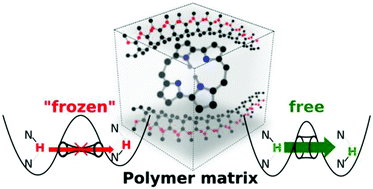Influence of local microenvironment on the double hydrogen transfer in porphycene†
Abstract
We performed time-resolved transient absorption and fluorescence anisotropy measurements in order to study tautomerization of porphycene in rigid polymer matrices at cryogenic temperatures. Studies were carried out in poly(methyl methacrylate) (PMMA), poly(vinyl butyral) (PVB), and poly(vinyl alcohol) (PVA). The results prove that in all studied media hydrogen tunnelling plays a significant role in the double hydrogen transfer which becomes very sensitive to properties of the environment below approx. 150 K. We also demonstrate that there exist two populations of porphycene molecules in rigid media: “hydrogen-transferring” molecules, in which tautomerization occurs on time scales below 1 ns and “frozen” molecules in which double hydrogen transfer is too slow to be monitored with nanosecond techniques. The number of “frozen” molecules increases when the sample is cooled. We explain this effect by interactions of guest molecules with a rigid host matrix which disturbs symmetry of porphycene and hinders tunnelling. Temperature dependence of the number of hydrogen-transferring molecules suggests that the factor which restores the symmetry of the double-minimum potential well in porphycene are intermolecular vibrations localized in separated regions of the amorphous polymer.

- This article is part of the themed collection: 2020 PCCP HOT Articles


 Please wait while we load your content...
Please wait while we load your content...